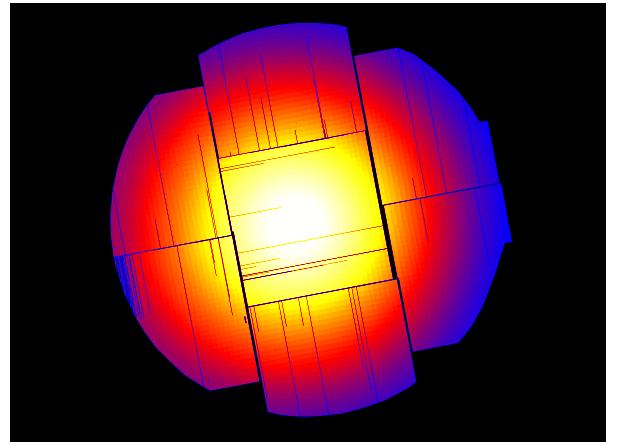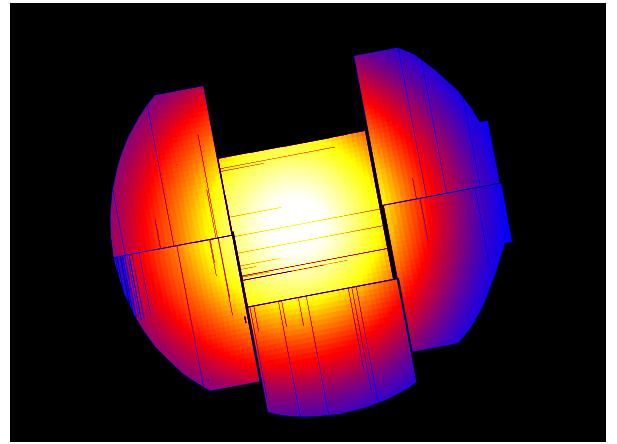XMM-Newton EPIC MOS1 CCD6 Update - XMM-Newton
XMM-Newton EPIC MOS1 CCD6 Update
EPIC MOS1 Event of Rev. 961
Contents / Updates
|
- Introduction - Impacts on data reduction - MOS1 CCD1 new hot column (near boresight): Suppression and mitigation |
23 March 2005: Introduction
At about 01:30 hrs.UT on 09 March, 2005, during XMM-Newton revolution 961, an event was registered in the focal plane of the EPIC MOS1 instrument. The characteristics of the event were reminiscent of very similar, but less energetic events registered in the MOS1 focal plane on September 17 (PDF), 2001, the MOS2 focal plane on August 12, 2002, and the pn focal plane on October 19, 2000, which were attributed to micrometeoroid impacts scattering debris into the focal plane. In each MOS case a bright flash of light caused data buffer overflows for the CCDs across the whole focal plane, and in all cases a number of new hot or defective pixels were subsequently mapped and masked. The consequences of the recent event appear to be more significant.
In the period immediately following the light flash it became apparent that MOS1 CCD6 was no longer recording events, and that all CCD6 pixels were, in effect, returning signal at the saturation level. Standard recovery procedures were immediately applied, but had no effect on the observed behaviour, raising the possibility that CCD6 had sustained significant damage. Evidence of a limited number of new hot pixels elsewhere in the MOS1 focal plane was also recorded. These other effects are relatively minor.
At the time of writing this note, scientific observations are continuing normally with XMM-Newton, including MOS1, but with CCD6 switched off. Intensive investigations are underway involving the ESA Operations Team and the instrument PI team in an effort to fully characterise changes in the instrument status.
While every effort will be made to minimise impacts of this event on data flow and service to our users, Community colleagues will understand that very careful and painstaking investigations now need to continue until we fully understand the impacts of this event for the instrument. Precise test operations will be carried out, with prior validation in the laboratory on the spare instrument chain. Any ripple-on effects throughout the system must be carefully evaluated.
However, apart from the disabling of MOS1 CCD6 our baseline at this time is to maintain normal data deliveries from XMM-Newton.
Observers are invited to monitor this web page for news about the progress of the investigations, and for advice on any adaptations that might be needed in the data processing chain to cope with a new status of MOS1 CCD6. That said, it is anticipated that impacts on data reduction will be minimal, and indeed that the scientific impacts, even if CCD6 cannot be recovered, will be small.
11 April 2005: Impacts on data reduction
Using SAS 6.1 we have analysed data corresponding to the observation 0305540501 performed on March 8-10 2005, during which CCD6 on the EPIC MOS 1 instrument stopped sending data. The analysis shows that there are neither problems for reducing data taken after CCD6 loss, nor the necessity of adapting any parameter of the data reduction. The following two images show the exposure maps corresponding to the exposures before and after the event, as derived by the SAS task eexpmap using default parameters (after the event lists were derived using emproc, also with default parameters).

Exposure map corresponding to exposures before the loss of MOS1 CCD6.

Exposure map corresponding to exposures after the loss of MOS1 CCD6.
For a source detected on a MOS1 chip neighbouring CCD6, the problems both for detection and for PSF extrapolation are not different from the ones posed by any source close to any other MOS1 edge, since the exposure map with the derived mask blends out the CCD6 region.
30 June 2005: MOS1 CCD1 new hot column (near boresight): Suppression and mitigation
Immediately following the Rev.961 event, a new hot column (designated M below) appeared on MOS1 CCD1. This originates from a defect at position (RAWX,RAWY)=(318,572) approximately, in the SAS coordinate system, which is blooming into the rest of column 318.
Column M passes 3 to 4 pixels away from the nominal target position on CCD1 when EPIC-pn is the prime instrument, and it passes 9 to 10 pixels from the target position when RGS is prime, therefore crossing, especially in the first case, a significant fraction of the on-axis source PSF.
The behaviour of this column has been monitored and diagnostics recorded over time for a range of instrument operating modes. The characteristics of the column have stabilised over time. As a result the following operational measures are being taken and recommendations for data reduction are made.
A detailed description of the properties of this defect is given in XMM-SOC-INST-TN-0024, Issue 1.2 "The new hot column in MOS1 CCD1 after the MOS1 event in Rev. 0961: Proposal for corrective actions", M. Stuhlinger et al. A summary of the main implications for observation handling is given immediately below.
On-board offset adjustment
The value of the onboard offset for the affected column will be adjusted upward by 19 ADU, starting with revolution 1028 on July 20, 2005. For data recorded after application of this database update, on-ground SAS data reduction by the user will be completely transparent to any damage to this column.
Steps in ground-based data reduction for pre-Rev.1028 data
For data recorded before the application of the modified on-board offset correction, the elevated offset in this column generates a lot of noise events at low energy above the low energy threshold, and the whole column is identified as bad by embadpixfind and masked out in the calibrated event list. The influence of the M-column on adjacent columns has been estimated to be minimal, although for a few revolutions after the impact the count rate on the adjacent columns (columns 317 and 319) was reduced by up to half due to pattern migration. The effect turned out to be negligible on bright sources.
Therefore users are advised to continue to apply the selection #XMMEA_EM to the MOS event list to generate spectra for on-axis sources, and not to apply FLAG==0. The more conservative selection, FLAG==0, masks out also the two adjacent columns. Therefore 3 columns are removed, causing the loss of up to 10-15% of the photons of an on-axis source when EPIC-pn is prime, and 5-10% when RGS is prime. Further, the current SAS (6.1) does not take into account these adjacent missing columns in the computation of the effective area. Therefore the absolute flux/normalisation of a source is too low when selecting FLAG==0 by 5-10%. The measured absolute flux/normalisation should be correct for spectra selected with #XMMEA_EM. Depending on the exact position of the source with respect to the M-column, and the size and shape of the extraction region, the errors could vary somewhat (see XMM-SOC-INST-TN-0024, Issue 1.2). A better handling of the effective area calculation will be implemented in the next SAS version.
However, apart from the normalisation the model parameters are found to be same within errors when using FLAG==0 or #XMMEA_EM.
| NOTE: | Apart from any effects related to the Rev.961 event, for some bright and soft sources, e.g. isolated neutron stars or supernova remnants, some other columns are masked out with the current SAS because they exhibit too low offsets that have developed since launch. Recommended handling of these columns is discussed in EPIC technical note EPIC-SAP-JBB-02, Version 1.1 "Should we keep columns adjacent to bad columns for spectral analysis with the EPIC-MOS ?", by J. Ballet. |
- Removed a total of (1) style text-align:center;
- Removed a total of (1) align=center.
- Removed a total of (4) border attribute.








































 Sign in
Sign in
 Science & Technology
Science & Technology